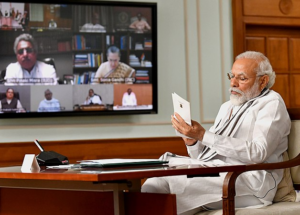By Emil Avdaliani

EXECUTIVE SUMMARY: India has initiated a grand strategic shift away from active engagement with China and toward its outright containment. This evolution was long in coming, but recent military clashes in the Himalayas have accelerated the process. India’s emerging strategy undermines the notion of a multipolar world championed by Moscow and Beijing, putting into question the degree to which the liberal world order is in decline.
A grand strategic shift is taking place in India’s geopolitical calculus.
New Delhi has always been wary of Beijing’s growing economic and military power. But in the last couple of years, China’s moves in the Indo-Pacific region have entrenched the belief among the Indian political elite that their country has to pursue a more active foreign policy.
Beijing is pursuing many large infrastructure projects and military moves in the Indo-Pacific. The most critical of these includes China’s modernization of its military infrastructure in Tibet, which it is conducting at breakneck speed. The China-Pakistan Economic Corridor (CPEC), involving some $46 billion of investment into Pakistan and especially into territories claimed by India, also increases New Delhi’s longterm animosity toward Beijing.
Further afield, China is increasing its influence among the smaller South Asian states that border India’s eastern provinces. This issue connects with China’s “string of pearls” strategy—the development of ports that it will likely use for both commercial and military purposes in Pakistan, Sri Lanka, and elsewhere. The resulting Indian fears of Chinese encirclement are translating into growing calls in India for a more robust and proactive foreign policy stance.
The salient geography of the Indian subcontinent, which almost exactly corresponds to the modern state of India, provides an incomparable geopolitical advantage in that it provides control over major sea lanes from the Middle East to China. This advantage lies at the heart of India’s vision of the Indo-Pacific. India is essentially obliged to look to the south and southeast, as that direction represents the only corridor through which it can expand its geopolitical clout. (India is closed off by impassable mountains to the north and by its rivalry with Pakistan to the northwest.)
But it is also clear to New Delhi that reaching the same level of military industrialization as that of China is impossible. To compensate for this disadvantage, it is imperative for India to draw closer to the region’s other maritime powers. Australia, New Zealand, and Japan—the other states that are most sensitive to the growth of China’s military power—are natural candidates for cooperation and possibly even alliance-building.
This was the rationale for the construction of the Quadrilateral Security Dialogue (QUAD). While it is not quite a full-scale military alliance, cooperation within QUAD is growing, with Australia and Japan increasingly responsive to India’s concerns and vice versa. However, it still needs external backing, namely from the US. Unlike in other regions, the Indo-Pacific has seen continuous, if not steadily growing, American attention through diplomatic, military, and economic measures.
The imperatives commanding the foreign policies of each member of QUAD suggest that this is an emerging long-term geopolitical development. Changes within governments (such as in Japan following the recent resignation of longtime PM Shinzo Abe) do not alter the need to contain China.
More importantly, the shift in India has repercussions for wider Eurasia and indeed for the new global order. Rivalry with China means that organizations like BRICS no longer enjoy their erstwhile popularity. The same goes for the Shanghai Cooperation Organization. Both groupings boasted geopolitical weight because of India’s and China’s concurrent memberships. The two states, together with Russia, were to have built a new world order based on multipolarity as opposed to the US-led liberal vision. But with the China-India rivalry in full swing, those hopes have been dashed. Any deep cooperation (such as the transfer of high-tech military hardware or the staging of military drills in the Indo-Pacific) between Russia and China would go against India’s interests and cause friction with Moscow.
It will now be increasingly up to Russia and China to pursue a new world vision. How successful they will be is a matter for another discussion. For India’s part, it has essentially opted out of the larger Eurasian vision and will be sticking with the US and QUAD.
A number of challenges are hindering India’s rise. While the US is increasingly betting on New Delhi’s ability to successfully counterbalance Beijing’s military power because of decades-long military cooperation (technology transfers, arms sales, and joint exercises), the process has been slow. China’s pace has far outstripped India’s. This is clearly evident in the troubles India is now experiencing with robust Chinese troops up in the mountains.
Far more worrisome is a disadvantage India currently suffers vis-à-vis China in the naval arena. New Delhi has not fully made use of its geographic advantages and the military superiority it had in previous decades through fruitful cooperation with the West and even Russia.
Still, India’s “containment” of China will continue to crystallize in the coming years. The process will arduous and could involve clashes in the Himalayas as well as further moves by China in the Indo-Pacific. The final outcome is far from clear, and the expectation of total defeat for one power and victory for the other does not correspond to developments on the ground.
The struggle will be long and highly competitive, and both parties will need an array of allies to secure necessary advantages. But both will also limit their behavior to stay just shy of outright one-on-one military conflict. Perhaps some version of a Soviet-American Cold-War-style proxy competition could develop, as is already unfolding in the economic and diplomatic realms.
Crucial to this rivalry will be the West’s position. Much will depend on how far it is willing to embrace the concept of a unified Indo-Pacific region and to collaborate with India militarily. NATO’s expansion of interests to Asia as well as Washington’s commitment could help India balance China’s positions.
No comments:
Post a Comment